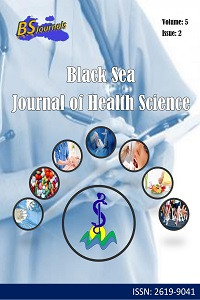Abstract
Patients infected with the COVID-19 virus may be symptomatic or asymptomatic. Most symptomatic patients present to the hospital with fever, cough, shortness of breath, runny nose, muscle and diarthrosis pain, diarrhea, and loss of taste. In addition, myocardial infarction (MI), myocarditis, stroke, tachyarrhythmias, and pulmonary embolism have also been reported. Although it is rare, bradyarrhythmia can also be seen in this patient group. Cardiopulmonary pathologies were excluded with transthoracic echocardiography, laboratory analyses, thorax computed tomography and cardiac magnetic resonance imaging. In this study, we aimed to present a patient infected with COVID-19, who had no cardiac or pulmonary involvement but had a temporary atrioventricular (AV) complete block.
Keywords
COVID-19 Bradyarrhythmia High-degree atrioventricular block SARS-CoV-2 Atrioventricular complete block
Supporting Institution
The authors declare no conflict of interest or any financial support.
References
- Chinitz JS, Goyal R, Harding M, Veseli G, Gruberg L, Jadonath R, Maccaro P, Gandotra P, Ong L, Epstein LM. 2020. Bradyarrhythmias in patients with COVID-19: Marker of poor prognosis? Pacing Clin Electrophysiol, 43(10): 1199–1204.
- Garrott K, Kuzmiak-Glancy S, Wengrowski A, Zhang H, Rogers J, Kay MW. 2017. K (ATP) channel inhibition blunts electromechanical decline during hypoxia in left ventricular working rabbit hearts. J Physiol, 595(12): 3799–3813. https://doi.org/10.1113/JP273873.
- Huang C, Wang Y, Li X, Ren L, Zhao J, Hu Y, Zhang L, Fan G, Xu J, Gu X, Cheng Z, Yu T, Xia J, Wei Y, Wu W, Xie X, Yin W, Li H, Liu M, Cao B. 2020. Clinical features of patients infected with 2019 novel coronavirus in Wuhan, China. Lancet, 395(10223): 497–506. https://doi.org/10.1016/S0140-6736 (20)30183-5.
- Kir D, Mohan C, Sancassani R. 2020. Heart break: An unusual cardiac manifestation of COVID-19. JACC, 2(9): 1252–1255. https://doi.org/10.1016/j.jaccas.2020.04.026.
- Liu PP, Blet A, Smyth D, Li H. 2020. The Science Underlying COVID-19: Implications for the Cardiovascular System. Circulation, 142(1): 68–78. https://doi.org/10.1161/CIRCULATIONAHA.120.047549.
- Madjid M, Safavi-Naeini P, Solomon SD, Vardeny O. 2020. Potential Effects of Coronaviruses on the Cardiovascular System: A Review. JAMA Cardiol, 5(7): 831–840. https://doi.org/10.1001/jamacardio.2020.1286.
- Ronco C, Reis T. 2020. Kidney involvement in COVID-19 and rationale for extracorporeal therapies. Nature Reviews. Nephrol, 16(6): 308–310. https://doi.org/10.1038/s41581-020-0284-7.
- Vetter P, Vu DL, L’Huillier AG, Schibler M, Kaiser L, Jacquerioz F. 2020. Clinical features of covid-19. BMJ, 369: 1470. https://doi.org/10.1136/bmj.m1470.
- Wang D, Hu B, Hu C, Zhu F, Liu X, Zhang J, Wang B, Xiang H, Cheng Z, Xiong Y, Zhao Y, Li Y, Wang X, Peng Z. 2020. Clinical characteristics of 138 hospitalized patients with 2019 novel coronavirus-infected pneumonia in Wuhan, China. JAMA, 323(11): 1061–1069. https://doi.org/10.1001/jama.2020.1585.
- Wang Y, Wang Z, Tse G, Zhang L, Wan EY, Guo Y, Lip GYH, Li G, Lu Z, Liu T. 2020. Cardiac arrhythmias in patients with COVID-19. J Arrhythmia, 36(5): 827–836. https://doi.org/10.1002/joa3.12405.
- Zhou P, Yang XL, Wang XG, Hu B, Zhang L, Zhang W, Si HR, Zhu Y, Li B, Huang CL, Chen HD, Chen J, Luo Y, Guo H, Jiang RD, Liu MQ, Chen Y, Shen XR, Wang X, Shi ZL. 2020. A pneumonia outbreak associated with a new coronavirus of probable bat origin. Nature, 579(7798): 270–273. https://doi.org/10.1038/s41586-020-2012-7.
Abstract
References
- Chinitz JS, Goyal R, Harding M, Veseli G, Gruberg L, Jadonath R, Maccaro P, Gandotra P, Ong L, Epstein LM. 2020. Bradyarrhythmias in patients with COVID-19: Marker of poor prognosis? Pacing Clin Electrophysiol, 43(10): 1199–1204.
- Garrott K, Kuzmiak-Glancy S, Wengrowski A, Zhang H, Rogers J, Kay MW. 2017. K (ATP) channel inhibition blunts electromechanical decline during hypoxia in left ventricular working rabbit hearts. J Physiol, 595(12): 3799–3813. https://doi.org/10.1113/JP273873.
- Huang C, Wang Y, Li X, Ren L, Zhao J, Hu Y, Zhang L, Fan G, Xu J, Gu X, Cheng Z, Yu T, Xia J, Wei Y, Wu W, Xie X, Yin W, Li H, Liu M, Cao B. 2020. Clinical features of patients infected with 2019 novel coronavirus in Wuhan, China. Lancet, 395(10223): 497–506. https://doi.org/10.1016/S0140-6736 (20)30183-5.
- Kir D, Mohan C, Sancassani R. 2020. Heart break: An unusual cardiac manifestation of COVID-19. JACC, 2(9): 1252–1255. https://doi.org/10.1016/j.jaccas.2020.04.026.
- Liu PP, Blet A, Smyth D, Li H. 2020. The Science Underlying COVID-19: Implications for the Cardiovascular System. Circulation, 142(1): 68–78. https://doi.org/10.1161/CIRCULATIONAHA.120.047549.
- Madjid M, Safavi-Naeini P, Solomon SD, Vardeny O. 2020. Potential Effects of Coronaviruses on the Cardiovascular System: A Review. JAMA Cardiol, 5(7): 831–840. https://doi.org/10.1001/jamacardio.2020.1286.
- Ronco C, Reis T. 2020. Kidney involvement in COVID-19 and rationale for extracorporeal therapies. Nature Reviews. Nephrol, 16(6): 308–310. https://doi.org/10.1038/s41581-020-0284-7.
- Vetter P, Vu DL, L’Huillier AG, Schibler M, Kaiser L, Jacquerioz F. 2020. Clinical features of covid-19. BMJ, 369: 1470. https://doi.org/10.1136/bmj.m1470.
- Wang D, Hu B, Hu C, Zhu F, Liu X, Zhang J, Wang B, Xiang H, Cheng Z, Xiong Y, Zhao Y, Li Y, Wang X, Peng Z. 2020. Clinical characteristics of 138 hospitalized patients with 2019 novel coronavirus-infected pneumonia in Wuhan, China. JAMA, 323(11): 1061–1069. https://doi.org/10.1001/jama.2020.1585.
- Wang Y, Wang Z, Tse G, Zhang L, Wan EY, Guo Y, Lip GYH, Li G, Lu Z, Liu T. 2020. Cardiac arrhythmias in patients with COVID-19. J Arrhythmia, 36(5): 827–836. https://doi.org/10.1002/joa3.12405.
- Zhou P, Yang XL, Wang XG, Hu B, Zhang L, Zhang W, Si HR, Zhu Y, Li B, Huang CL, Chen HD, Chen J, Luo Y, Guo H, Jiang RD, Liu MQ, Chen Y, Shen XR, Wang X, Shi ZL. 2020. A pneumonia outbreak associated with a new coronavirus of probable bat origin. Nature, 579(7798): 270–273. https://doi.org/10.1038/s41586-020-2012-7.
Details
| Primary Language | English |
|---|---|
| Subjects | Internal Diseases |
| Journal Section | Case Report |
| Authors | |
| Publication Date | May 1, 2022 |
| Submission Date | September 27, 2021 |
| Acceptance Date | November 25, 2021 |
| Published in Issue | Year 2022 Volume: 5 Issue: 2 |


